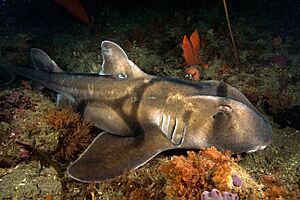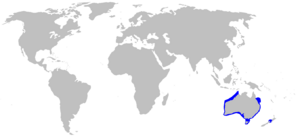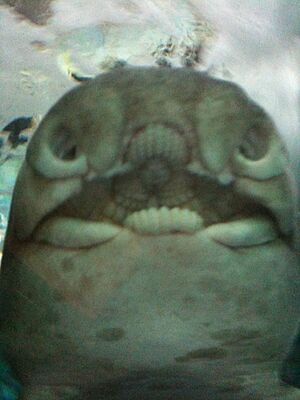Port Jackson shark facts for kids
Quick facts for kids Port Jackson shark |
|
|---|---|
 |
|
| Conservation status | |
| Scientific classification | |
| Genus: |
Heterodontus
|
| Species: |
portusjacksoni
|
 |
|
| Range of Port Jackson shark (in blue) | |
The Port Jackson shark (Heterodontus portusjacksoni) is a special type of bullhead shark. It is active mostly at night and lays eggs. You can find these sharks in the coastal waters of southern Australia, including the famous Port Jackson area.
This shark has a big, rounded head with clear ridges above its eyes. It also has dark brown, harness-like stripes on its lighter grey-brown body. These sharks can grow up to about 5.4 feet (1.65 meters) long. They are the largest sharks in their group, called Heterodontus.
Port Jackson sharks are known for traveling. They move south in the summer and return north in the winter to have their babies. They eat animals with hard shells, like mollusks, crustaceans, and sea urchins, as well as other fish. It's easy to spot this shark because of its unique harness-like markings. These marks go across its eyes, along its back to the first fin, and then across its sides. It also has a spine in front of both of its back fins.
Contents
Where Port Jackson Sharks Live
The Port Jackson shark lives only in the mild waters around southern Australia. You can find them from southern Queensland, down to Tasmania, and west to the central coast of Western Australia. There have been a few rare sightings near New Zealand too.
Scientists think there are two main groups of these sharks in Australia. One group lives from northeastern Victoria to Western Australia. The other group lives from southern Queensland to New South Wales. It's believed this shark species first appeared off the coast of South Africa.
These sharks usually live in water less than 330 feet (100 meters) deep. However, they have been seen as deep as 900 feet (275 meters).
The shark usually stays on or near the ocean floor, which is where it finds its food. They often live in rocky areas, but sometimes they use sandy or muddy spots, or even areas with seagrass. During the day, when they are not very active, they rest in flat areas. These spots offer shelter from ocean currents, like caves or rocky places.
Movement and Migration
Port Jackson sharks are active at night. They are most busy in the late evening, before midnight, and then slow down before sunrise. Studies show that sharks in the wild and those in aquariums move in similar ways. Their movements depend on the time of day, if they are male or female, and their travel plans for breeding.
These sharks travel every year to special bays along the coast to breed. The male sharks arrive first. The females come later and stay longer. This might help protect their newly laid eggs from other animals that might eat them. Both male and female sharks tend to return to the same places each year.
Scientists have used special sensors, like Fitbits for sharks, to track their movements. These sensors help them understand what the sharks are doing, like resting, swimming, or eating.
Appearance of the Port Jackson Shark
Port Jackson sharks can grow to about 5.4 feet (1.65 meters) long. They look similar to other sharks in their group. They have a wide, blunt, flat head, a fin near their tail (called an anal fin), and ridges above their eyes.
However, some features make them easy to identify. Their teeth and the harness-like markings on their bodies are very unique. These markings go from their eyes to their first back fin (dorsal fin) and then across the rest of their bodies. Both dorsal fins are about the same size, and each has a spine at the front edge. Some people say these spines might be poisonous. Other ways to tell them apart are their small mouths and their nostrils, which are connected to their mouths.
The sharks have grey-brown bodies with black bands. These bands cover a large part of their sides and backs. One band wraps over their face and goes to their eyes. Another band, shaped like a harness, goes around their back and down to their side fins (pectoral fins). They also have thin, dark stripes on their backs. These stripes run from their tail fin (caudal fin) to their first dorsal fin.
Port Jackson Shark Teeth
The teeth of the Port Jackson shark are one of its most special features. Unlike other sharks, their teeth are different in the front and back of their mouths. The front teeth are small, sharp, and pointed. The back teeth are flat and blunt.
These teeth work together to help the shark eat. The front teeth hold and break the shells of the mollusks and sea urchins they eat. The back teeth then crush and grind these shells. Young Port Jackson sharks have sharper teeth. They eat more soft-bodied prey than adult sharks do.
How Port Jackson Sharks Breathe
The Port Jackson shark has five gills. Gills help fish breathe underwater. Behind each eye, the shark has a special breathing organ called a spiracle.
Port Jackson sharks can eat and breathe at the same time. This is unusual for most sharks. Many sharks need to swim with their mouths open to push water over their gills. But the Port Jackson shark can pump water into its first large gill slit. The water then flows out through the other four gill slits. By pumping water over its gills, the shark doesn't need to move to breathe. This means it can lie on the ocean bottom for a long time.
Reproduction and Life Cycle
Male Port Jackson sharks are ready to have babies when they are 8 to 10 years old. Females are ready between 11 and 14 years old. They are oviparous, which means they lay eggs instead of giving birth to live young.
Their breeding season happens once a year, starting in late August and lasting until mid-November. During this time, the female lays eggs in pairs every 8 to 17 days. She can lay up to eight pairs of eggs during one season. The eggs take about 10 to 11 months to develop before the baby sharks, called neonates, hatch. Sadly, many eggs, about 89.1%, do not survive. Most of them are eaten by other animals.
How Port Jackson Sharks Digest Food
Digesting food can take a long time for a Port Jackson shark. Food goes from the mouth to a J-shaped stomach. Here, food is stored, and digestion begins. If the shark eats something it doesn't want, it can cough it back up. They can even turn their stomachs inside out and spit them out of their mouths to get rid of unwanted things!
One big difference in shark digestion compared to mammals is their very short intestine. This short length works because the intestine has a special spiral valve. This valve has many turns inside a short section. This creates a very long surface area for food to be digested. Food has to travel around inside this short-looking gut until it's fully digested. Then, any waste passes out.
The largest internal organ in sharks is their huge liver. It often fills most of their body. Port Jackson sharks eat sea urchins, mollusks, crustaceans, and fish. They often eat black sea urchins. These sharks look for food at night when their prey are most active. During the day, they often use caves and rocky areas for protection.
The teeth of the Port Jackson shark are very different from other shark species. They are not jagged. The front teeth have a very different shape from the back teeth. This is why their genus name, Heterodontus, means "different tooth." The front teeth are small and pointed. The back teeth are wide and flat. These teeth work to hold and break, then crush and grind the shells of mollusks and sea urchins. Young Port Jackson sharks have more pointed teeth and eat more soft-bodied prey than adults. They can also suck in water and sand from the bottom, blow the sand out through their gills, and keep the food to swallow.
Behavior and Learning
Adult Port Jackson sharks are often seen resting in caves in groups. They seem to prefer hanging out with other sharks of the same sex and size. Young Port Jackson sharks, however, don't seem to be as social. A study showed that young sharks in tanks didn't prefer to spend time near other sharks, even if they knew each other.
Young Port Jackson sharks also have unique personalities, just like humans! Some were braver than others when exploring new places. They also reacted differently to stressful situations, either freezing or trying to escape.
Young Port Jackson sharks can also learn. They can learn to connect things like bubbles, LED lights, or sounds with getting food. They can also tell the difference between different amounts (like counting). And they can learn by watching what other sharks do.
In some lab tests, male sharks were shyer than females. Also, sharks became bolder the more times they did the same experiment. In experiments with different types of music, none of the sharks learned to tell the difference between jazz and classical music.
Port Jackson Sharks and Humans
The Port Jackson shark is not very important to humans for fishing or food. It is also not an endangered species. However, it can sometimes be caught by accident when people are fishing for other things.
These sharks are not dangerous to humans. In October 2011, a man was bitten by a Port Jackson shark at Elwood Beach in Australia. The bite did not break the skin, and the man was able to swim away while the shark was still attached to his leg.
Conservation Efforts
The Port Jackson shark is listed as "Least Concern" by the World Conservation Union (IUCN). This means they are not currently at high risk of disappearing. However, a very high number of their egg capsules (about 89.1%) do not survive.
Scientists don't know much about what animals eat Port Jackson sharks. While other sharks, like the crested bullhead shark, are known to eat Port Jackson shark embryos, the biggest threats are likely larger sharks such as white sharks and the broadnose sevengill shark.
In June 2018, the Department of Conservation in New Zealand called the Port Jackson shark "Vagrant." This means it's a visitor to their waters but is "Secure Overseas."




